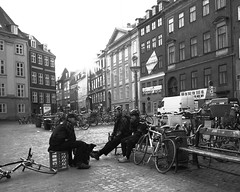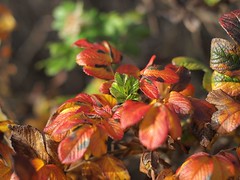On focusing on the essentials
Sigfrid Lundberg's Stuff 2011-05-07![]()
Photography is visual storyteling, among other things. The stories I want to tell isn't about photographic equipment but about us human beings, our environments, emotions and about our time inasmuch as one can learn anything about that from what I see in my own life.

Figure 1. This is what I carry with me in terms of photographic equipment. Gadgets from left to right (links takes you to my corresponding Flickriver sets). (1) Nikkor-PC Auto 105mm f/2.5, (2) Voigtlander F Mount to micro four thirds adaptor (3) Olympus PEN E-P2 with M-Rokkor 40mm f/2.0 mounted using a Leica M to micro four thirds adaptor (4) Nikkor-O Auto 35mm f/2.0 and finally (5) Voigtländer Heliar 15mm f/4.5.
Equipment should really be unimportant. Ernst Haas is
reported to have made the following remark on the question which camera
brand is best: All of them can record what you are seeing. But,
you have to SEE.
(Quoted from Ken Rockwell's Your Camera
Doesn't Matter. He claims that the anecdote comes from Murad
Saÿen. Anyway, Rockwell's essay on photographic quality is brilliant.)
However, it is the equipment that give me the means for telling those stories. A camera consists of a lens and a body. Today a body is obsolete in two or three years time and their longevity is decreasing and will approach that of a mobile phone. The lens is a serious matter for me, and I cannot stand the idea to acquire new lenses just because I've bought a new body.
About a month after I had bought my new digital system camera I decided that I wanted to use my old Nikon lenses, and that I wanted to get a small but useful collection of manual prime lenses (Figure 1).
There are issues with using manual lenses. One of them is that you have to focus. Manually. This entry is about focusing. I illustrate it with examples from my own photography, which may not be perfectly sharp.
Thom Hogan has written about using manual lenses on micro four third bodies. His conclusions are:

Figure 2. The first out-door beer in the spring is most likely the best beer under the sun. Street photography using Voigtländer Super-Wide Heliar 15mm f/4.5.
My personal take is that manual focus really only works well in two situations: where you have a stationary subject and time; and when you use depth of field and a preset focus distance (ala Henri Cartier-Bresson's shooting style). (Thom Hogan)
I have no problems with Henri Cartier-Bresson's shooting style. I use that all the time. I mount my 15mm Heliar using a Leica M adaptor and at aperture 8 I have a depth of field from less than a meter to infinity (Figure 2).
The Flickr group Decisive Moment devoted to street photography in Cartier-Bresson's style. The guidelines states, among other things that
There should be a Background that contributes to the overall composition. In most cases this Background is in focus. Decisive Moment.

Figure 3. My Nikkor-O Auto 35mm f/2.0 and the 40mm M-Rokkor coexists because they occupy slightly different ecological niches. Nikkor-O has a closest range at about 30cm is it is an almost macro lens. At aperture 2 and 2.8 it has a very nice bokeh.
So, what was enforced by necessity, the level of technological development between 1930-1960 has become an artitistic characteristic of a genre. However, the Henri Cartier-Bresson shooting style is more or less implemented in hardware in all point and shoot compact cameras. Mobile cameras have a very large depth of field, since the very small sensor gives you a standard lens with a small focal length.
I have a need for being able to take photos of small
things. Obviously a macro lens would have been ideal, but I have not yet
been able to acquire one of those. However, my two Nikon F mount lenses
are both almost macro
. The 35mm lens allows me to focus on
objects as close as about 25cm (Figure 3).
To focus swiftly on a moving insect or something as close as 25cm with a paperthin DOF is difficult. I have tried it, but not very much. A preset focus distance won't help very much.
On the street you can choose a stage where you expect a subject may appear. You can focus on something on adjust the DOF and wait. Press the shutter in the decisive moment. This is preset focus, mentioned by Hogan.
With my 35mm (Figure 3), 40mm (Figure 4 & 5) and 105mm lenses (Figure 6) I have to focus and do so accurately. The four people on Figure 4 is a very good example on a shot with preset focus. I focused on the door behind the people when I saw them approaching, and got two shots while they passed each other.
Then we have the knob on my roller blinds (Figure 5). The knob is sharp. You can find it in the lower right corner of the image. The dirt on the window is in focus as well. I took photo just because I wanted to demonstrate how you can control the focusing of a manual lens. I've tried in vain to repeat that with an auto-focus lens.
There are three issues for me here. (i) The feeling of the lens when you use it, (ii) You're ability to control the depth of field and (iii) the attitude that photographic equipment is some kind of electronic consumer equipment stuff, rather than means for artistic creation.
Manual focus lenses permit me to focus on the essentials. What I can see. Not on what the camera designers think I would like to focus on. When I fail, I cannot blame it on anyone else.
Figure 6. Two pair of shoes. Nikkor-PC Auto 105mm f/2.5. Of the lenses discussed here, this is the hardest one to focus. But this is a point-focus-shoot capture, one of those where manual focus lenses are useless according to Hogan.
You have to practice for months to do this fast. I'm not there yet and estimate that I succeed on less than half of the images I capture with this lens.
stuff by category || year
- About me
- Ageing
- Archival description
- Art
- Colophon
- Creative Commons
- Digital collections
- Digital libraries
- Digital Object
- Digitization
- Economics
- Digital humanities
- eScience
- Essays
- Flickr
- Food and drink
- Hardware
- Harvesting
- Images
- Internet
- Lenses
- Literature
- Media
- Metadata
- Metadata processing
- Mothers
- Music, language & literature
- Neighbours
- Digital Object Stores
- Library catalogues
- Open Content
- Photography
- Poetry
- Digital preservation
- Programming
- Religion
- Reviews
- Software
- Souvenir
- Spirituality
- Stories
- Structural web design
- Text encoding
- The Library
- Typography
- Video
- Web indexing
- XML processing
- XML technologies
- XML web services
- Z39.50
- Zeitgeist
NB
My name is Sigfrid Lundberg. The stuff I publish here may, or may not, be of interest for anyone else.
On this site there is material on photography, music, literature and other stuff I enjoy in life. However, most of it is related to my profession as an Internet programmer and software developer within the area of digital libraries. I have been that at the Royal Danish Library, Copenhagen (Denmark) and, before that, Lund university library (Sweden).
The content here does not reflect the views of my employers. They are now all past employers, since I retired 1 May 2023.

This entry (On focusing on the essentials) within Sigfrid Lundberg's Stuff,
by
Sigfrid Lundberg
is licensed under a
Creative Commons
Attribution-ShareAlike 3.0 Unported License.



 Subscribe to my stuff
Subscribe to my stuff